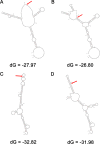Variants in ANRIL gene correlated with its expression contribute to myocardial infarction risk
- PMID: 28107200
- PMCID: PMC5355039
- DOI: 10.18632/oncotarget.14721
Variants in ANRIL gene correlated with its expression contribute to myocardial infarction risk
Abstract
ANRIL (antisense non-coding RNA in the INK4 locus), located at the 9p21.3 locus, has been known to be closely associated with the risk of coronary artery disease (CAD). To date, studies of the 9p21.3 variants on CAD risk mainly focus on the non-coding region of ANRIL. However, the biological significance of the variants on ANRIL promoter and exons is still unknown. Here we investigate whether the variants on ANRIL promoter and exons have an effect on myocardial infarction (MI) risk, and further analyze the association of these variants with the expression of ANRIL transcript. We did not find any common variants with minor allele frequencies (MAF) larger than 5% in ANRIL promoter by sequencing 1.6kb upstream of the start codon. Unconditional logistic regression analysis revealed that two SNPs in ANRIL exons, rs10965215 and rs10738605, were significantly associated with MI risk. Further studies revealed that ANRIL transcript EU741058.1 expression levels of rs10965215 and rs10738605 risk genotypes were borderline lower than those of protective genotypes. Our data provide the evidence that the variants rs10965215 and rs10738605 in ANRIL exons contribute to MI risk in the Chinese Han population which might be correlated with the expression of its transcript EU741058.1.
Keywords: ANRIL; Gerotarget; myocardial infarction; risk; single nucleotide polymorphism.
Conflict of interest statement
The authors declare that there are no conflicts of interest.
Figures



References
-
- Li J, Li X, Wang Q, Hu S, Wang Y, Masoudi FA, Spertus JA, Krumholz HM, Jiang L, China PCG. ST-segment elevation myocardial infarction in China from 2001 to 2011 (the China PEACE-Retrospective Acute Myocardial Infarction Study): a retrospective analysis of hospital data. Lancet. 2015;385:441–451. - PMC - PubMed
-
- Helgadottir A, Thorleifsson G, Manolescu A, Gretarsdottir S, Blondal T, Jonasdottir A, Jonasdottir A, Sigurdsson A, Baker A, Palsson A, Masson G, Gudbjartsson DF, Magnusson KP, et al. A common variant on chromosome 9p21 affects the risk of myocardial infarction. Science. 2007;316:1491–1493. - PubMed
-
- van Setten J, Isgum I, Smolonska J, Ripke S, de Jong PA, Oudkerk M, de Koning H, Lammers JW, Zanen P, Groen HJ, Boezen HM, Postma DS, Wijmenga C, et al. Genome-wide association study of coronary and aortic calcification implicates risk loci for coronary artery disease and myocardial infarction. Atherosclerosis. 2013;228:400–405. - PubMed
MeSH terms
Substances
LinkOut - more resources
Full Text Sources
Other Literature Sources
Medical
Miscellaneous

